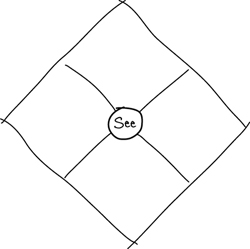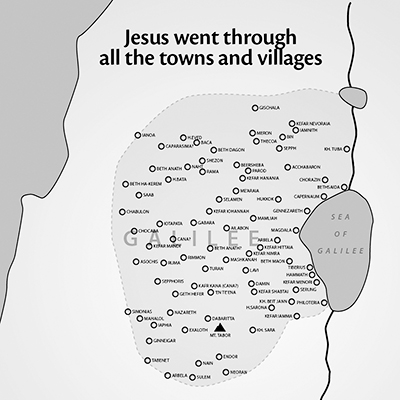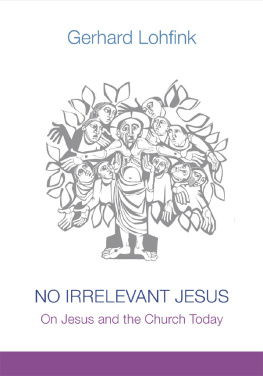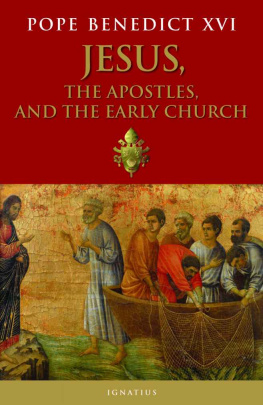1

Why Jesus Came

To fulfill what was said through the prophet Isaiah: Land of Zebulun and land of Naphtali, the Way of the Sea, beyond the Jordan, Galilee of the Gentiles the people living in darkness have seen a great light; on those living in the land of the shadow of death a light has dawned.
Matthew 4:14-16
Jesus was born in Bethlehem around 5 b.c. He grew up in Nazareth, a town of just a few hundred people in lower Galilee.
In Jesus day, the region of Galilee was a Jewish enclave surrounded by centers of pagan Greek culture left over from the conquests of Alexander the Great in the fourth century b.c . Rome was now the ruling power, but the Greek language, culture and religion continued to dominate. The population of the region was mixed, with most Jews living in the countryside and Gentiles living in the cities and border towns.
Galilee was no backwater. It had two major Greek citiesSepphoris and Tiberiasof 10,000 to 20,000 people each. A few miles from Nazareth was the great highway that stretched from Egypt to Syria. Along it flowed a constant stream of Greeks and Barbarians, as well as Roman soldiers. Sepphoris, an hours walk from Nazareth, was rebuilt by Herod Antipas as his capital in 4 b.c. Tradesmen were in high demand. Jesus would be apprenticed to his father, a tradesman who worked in timber, stone, and metal.
Jesus was raised in a devout Jewish home. As a boy he attended the synagogue each Sabbath with his parents, brothers and sisters. Jesus grew up speaking Aramaic and at age five probably began learning to read the Torah
Galilee was fertile and The region was the breadbasket of Palestine, and wheat was a major commodity. Wine from Galilee was exported to Phoenicia; northern Galilee produced and exported olive oil. Tiberias was known for its textiles, pottery and glass, while Gennesaret was noted for its date palms and fruit trees. Fishing was a thriving business in Galilee, and salted fish was exported far and wide.
Despite this abundance, however, most Jews in the countryside lived a hard life. Roman rule meant that agricultural land was hard to retain. The problem began back in 34 b.c. when the Romans installed Herod I (the Great) as king over Judea and Galilee. Herod was corrupt. Wealthy and ruthless, he murdered anyone he suspected of opposing him: two high priests,
Within one generation Herod I had rebuilt Jerusalem and transformed the holy city into a Greco-Roman capital. Under the rule of Herod and his sons, Israel was a divided society. Herod surrounded himself with nobles, wealthy landowners, military commanders and the religious ruling families who controlled the Temple in Jerusalem and the position of high priest. This local elite submitted itself to Roman rule and promoted Greek culture and values.
Supporting the elite were their officialsbureaucrats, tax collectors, military officers and judges. These men enforced Herodian rule over the rest of society, which was divided into roughly three groups. The first group included self-employed merchants, craftsmen, fishermen and farmers who owned their land. Then there were the landless peasants who had lost their land through taxes, crop failure and debt. On the very outer fringe of society were the beggars, prostitutes and bandits.
Herod the Greats sons perpetuated these divisions. Herod Antipas (c. 20 b.c to a.d. 39) controlled Galilee during most of Jesus life. He introduced Greek culture and values, to the dismay of the ordinary people who sought to be faithful to Israels covenant. Herod Antipas luxurious palace in Tiberias was filled with Gentiles and decorated with idolatrous images.
The rural Jewish population longed for Yahweh to bring deliverance for his people. This was the setting of Jesus mission.
The Spirit of the Lord is on me,
because he has anointed me
to proclaim good news to the poor.
He has sent me to proclaim freedom for the prisoners
and recovery of sight for the blind,
to set the oppressed free,
to proclaim the year of the Lords favor. (Lk 4:18-19)
Jesus came proclaiming good news to the poornot just the economic poor but also those rejected as unclean,
In a.d. 28 Jesus submitted himself to baptism by his cousin John, identifying with sinful Israel, in need of cleansing and restoration. Jesus baptism also marked the time when Jesus would leave his carpenters workshop and take up the mission he was destined for. In his baptism Jesus committed to fulfill his mission, even if it meant persecution and death.
Before he could plunder Satans kingdom, Jesus would have to defeat Satan. The Spirit thrust Jesus out into the Judean desert on the western side of the Dead Sea, where Jesus faced his adversary for forty days and forty nights. Satan offered Jesus the kingdoms of the world, if only Jesus would bow down and worship him. Would Jesus use his power and unique status as Gods Son to serve himself, or would he accept the cup God had called him to drink?
Satan offered Jesus the chance to fulfill his mission and establish the kingdom without the cross. Instead Jesus saw his mission as saving people from their sins and from the just judgment of God. He chose to willingly follow the path laid out by his Father, even at the cost of his life.
On the Move in Galilee
Jesus returned to Galilee in the power of the Spirit, and news about him spread through the whole countryside.
Luke 4:14
Jesus issued a compelling call to a small band of disciples and took them throughout Galilee proclaiming the arrival of Gods rule, casting out demons and healing the sick. From town to town, in the synagogues, by the shores of the lake, in the open fields, in the market places and in homesevery settlement in the regionJesus declared that the kingdom of God was present.
Matthew records that Jesus ministry touched all 175 towns and villages of Galilee. To reach them all Jesus could rarely have stayed in one place for more than a few days; he would have been constantly on the move. By the end of his ministry, most of Galilees 200,000 people would either have met Jesus or have known someone who had.

Map 1.1. Some of the 175 towns and villages of Galilee that, according to Matthew, Jesus visited. See Eckhard J. Schnabel, Early Christian Mission, Vol. 2, Paul and the Early Church (Downers Grove, Ill.: IVP Academic, 2004), p. 1592.
Jesus left his home in Nazareth and made Capernaum his base. This harbor town of a thousand people was on the northwest shore of the Sea of Galilee and was known for fishing, agriculture and trade. From Capernaum Jesus and his disciples could reach dozens of small towns and villages within one or two days travel.
Jesus central concern was the kingdom, or reign, of God. Since childhood Jesus was taught that there was one God, Yahweh, who is Creator and Lord of all. He learned that through Abraham, God had chosen Israel to be his witness to the world. Through Israel the nations (Gentiles) would be drawn into Gods salvation. As he studied the prophet Isaiah, Jesus learned how in the last days God would send his Servant to suffer and die for the sins of his people. God would restore Israel through the obedience of his Servant, and the nations would hear the good news of salvation.
The kingdom could not be advanced or established by human effort. The kingdom of God was Gods act of breaking into history through this Servant Messiahs life, death and resurrection to save sinful humanity. Jesus identified himself as the Son of Man who, according to Daniel 7:13-14, will be given universal dominion. He also identified himself as the Servant of Isaiah (Is 4055) who will suffer and be rejected by men. Yet Gods purpose is that his innocent death will be as a ransom for many (Mk 10:45).












